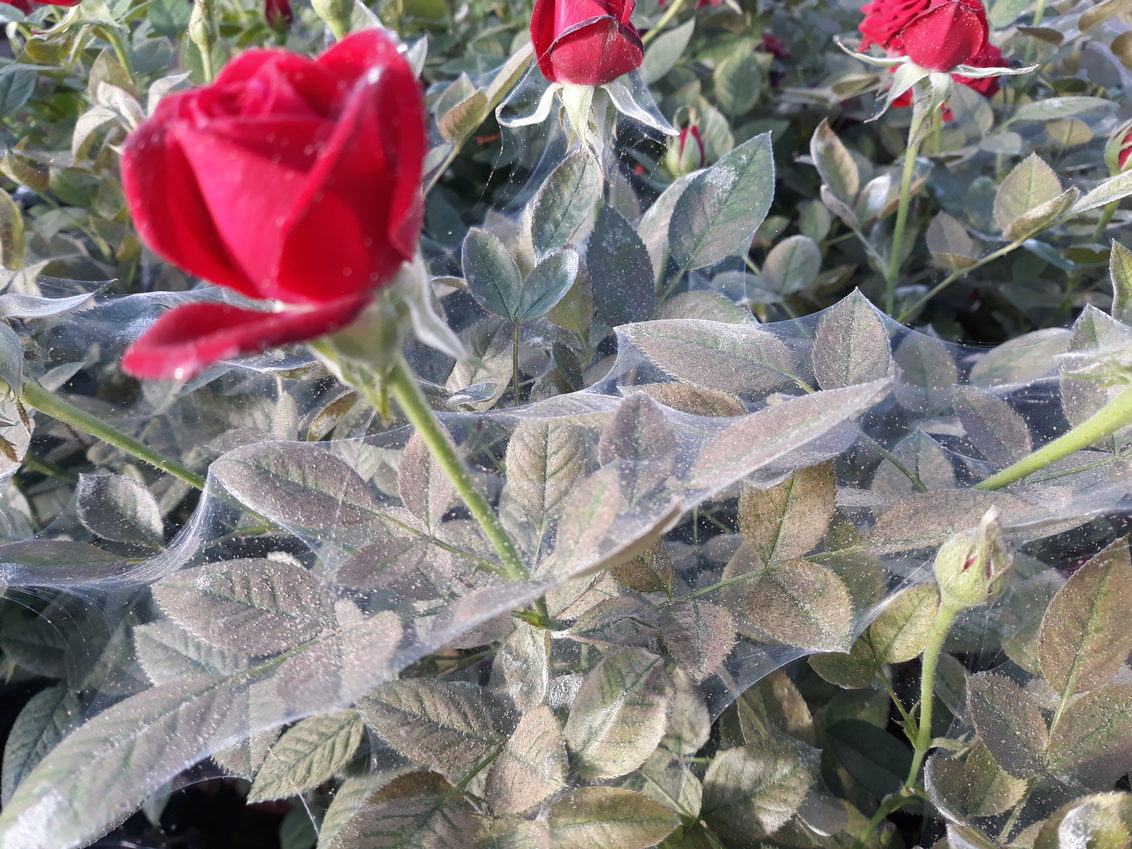Time to tackle spider mite

Given everything else growers have had to contend with this year I guess we can be thankful for a relatively typical season as far as pest outbreaks are concerned, with apparently few major issues.
One pest that seems to have generated more than its fair share of enquiries, however, is Tetranychus urticae, glasshouse red spider mite which is also known as two-spotted spider mite. Outbreaks are usually worst at the end of summer but this year the spell of hot dry weather we saw in spring may well have triggered some infestations.
It’s a pest favoured by warm, dry conditions either under protection or, despite its common name, on outdoor ornamentals. It can be a particular issue in glasshouses thanks to its rapid lifecycle – around 12 days at 21°C – where it can be active year-round if the temperature doesn’t drop below 16°C.
Whatever your experience has been with spider mite this year, the autumn clean-up is the corner stone to cultural control. Females overwinter in cracks or plant debris so make sure all growing areas are thoroughly cleaned – and disinfected where possible – and check less obvious overwintering places such as under ground-cover sheets or at the tips of canes. As with all pests and diseases, once you’ve started clean, regularly remove any crop debris and scout as often as practicable to pick up early signs of an outbreak. Control measures that deal with spider-mite eggs are particularly important.

Spider-mite attacks are most severe on stressed plants so good growing conditions are your first defence. Using a biostimulant such as Hicure to improve the plants’ health can only improve the crop’s resilience. In very dry weather use the irrigation system to raise humidity if necessary (which may also help offset the risk of other stress-related conditions) but keep a balance, as too high a humidity could encourage fungal pathogens.
Predatory instincts
The widespread use of biological control on ornamentals nurseries has really helped the industry with spider-mite management. Predatory mites are the mainstay. Phytoseiulus persimilis actively hunts and attacks all stages of the pest, but is best in warm, relatively humid conditions and can’t establish unless the pest is already present. Neoseiulus californicus and Amblyseius andersoni, both of which feed on spider-mite eggs, nymphs and adults, can be used preventively as they will survive in the pest’s absence – N. californicus is only licensed to be released in a glasshouse.
There’s also a predatory midge, Feltiella acarisuga, that feeds on all stages of spider mite, including eggs, and some of the more generalist biocontrol agents will provide useful control. Our colleagues at Fargro can give you more information about biological controls.
Successful integrated pest management (IPM) usually needs the backing of crop protection chemistry. Dynamec (abamectin) remains one of the most effective tools to bring spider-mite infestations back to the point where biologicals can take over – and has the benefit of an on-label approval for ornamentals in the UK. Abamectin’s effectiveness against spider mite has been prolonged by the ornamental industry’s approach to IPM, with few reports of resistance in UK spider-mite populations.
With resistance management in mind, other chemical actives effective against the pest include clofentezine (outdoor crops), etoxazole (protected crops) and spirodiclofen (outdoor crops), all under EAMUs.
Biorational treatments, such as fatty-acid and maltodextrin products and a formulation of natural pyrethrins with rapeseed oil with claims for activity against spider mites, can have a part to play too.
The biopesticide Beauveria bassiana is also an option, though be aware different products have different strains of this fungus and some are easier to use than others.
What to look for
Feeding by T. urticae causes tiny yellow spots on leaves that eventually multiply and coalesce into patches. Large populations create unsightly webbing and can distort growth.
Two other spider mite species can cause problems for ornamental plants: carmine spider mite, T. cinnabarinus; and fruit tree red spider mite, Panonychus ulmi, which can attack nursery stock. Consult your agronomist or crop adviser about the most appropriate control measures for these pests.
Click here to find out more about the life cycle of the spider mite in our Advice Hub.

